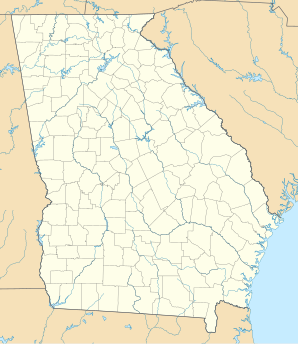Warm Springs, Georgia
| Warm Springs | ||
|---|---|---|
|
Location in Georgia
|
||
| Basic data | ||
| State : | United States | |
| State : | Georgia | |
| County : | Meriwether County | |
| Coordinates : | 32 ° 53 ′ N , 84 ° 41 ′ W | |
| Time zone : | Eastern ( UTC − 5 / −4 ) | |
| Residents : | 425 (as of 2010) | |
| Population density : | 137.1 inhabitants per km 2 | |
| Area : | 3.1 km 2 (approx. 1 mi 2 ) of which 3.1 km 2 (approx. 1 mi 2 ) are land |
|
| Height : | 281 m | |
| Postal code : | 31830 | |
| Area code : | +1 706 | |
| FIPS : | 13-80480 | |
| GNIS ID : | 0324851 | |
| Website : | www.warmspringsga.com | |
Warm Springs is a city of 425 people (as of 2010) in Meriwether County , Georgia in the United States . The urban area has a size of 3.2 km².
history
In the 19th century, residents of Georgia, particularly Savannah , sought protection from yellow fever in the surrounding hot water springs . The warm mineral springs (32 ° C) attracted the first settlers to the region at the beginning of the 19th century. In 1832, David Rose created the first tourist infrastructure in Warm Springs. Wealthy property owners and business people from the south used the various locations during the hot summer months. Among these places there was also a hotel near the warm springs at the foot of the Pine Mountains, which was frequented by influential guests such as Henry Clay and John C. Calhoun . In 1893 a larger Victorian-style hotel building with 180 rooms was built by the hot springs. Because the hotel was in Meriwether County, it was named "Meriwether Inn". It stood on a hill overlooking the fields and springs that became a large open-air swimming pool. With the connection to the railroad and stagecoach, the Inn attracted patrons from all over the southeast of the country. The decline of the spa began at the turn of the century .
In 1923 a group around George Foster Peabody , a well-known businessman from Columbus, Georgia, bought the property. In 1924, the future US President Franklin D. Roosevelt visited Warm Springs to recover from his poliomyelitis in the warm springs . Roosevelt was afraid of the "Inn" because of its inaccessible character with numerous steps and wooden construction and preferred to stay in the Pierson and McCarthy Cottages (before he built the Little White House). Despite a major boost from the change of ownership and the arrival of polio sufferers from across the country (amid the publicity surrounding Roosevelt's presence), Peabody sold the property to Franklin D. Rosevelt for $ 195,000 in 1926.
Roosevelt returned regularly to Warm Springs for two decades, and in 1927 he established the Georgia Warm Springs Foundation as a hospital for poliomyelitis patients. The resulting rehabilitation clinic is now called the Roosevelt Warm Springs Institute for Rehabilitation and treats around 6,000 patients per year.
Attractions
Roosevelt had a small country house built, which he used during his stays and in which he died on April 12, 1945. The property, known as the "Little White House", has been left in its original state and houses a museum.
The Roosevelt Warm Springs Institute for Rehabilitation is home to the Polio Hall of Fame , where the bronze busts of 15 polio researchers as well as Roosevelt and Basil O'Connor were placed in 1958 .
Movie
Franklin D. Roosevelt's illness and his stays in Warm Springs are the subject of the American television film Warm Springs . The city and the historic baths from the 1920s were the location for a large part of the scenes.
Source
- Warm Springs - History
Web links
- Homepage of Warm Springs (English)
Individual evidence
- ↑ US Census Bureau Administration and Customer Services Division: US Census Bureau Publications - Census of Population and Housing. Retrieved May 11, 2018 (American English).

